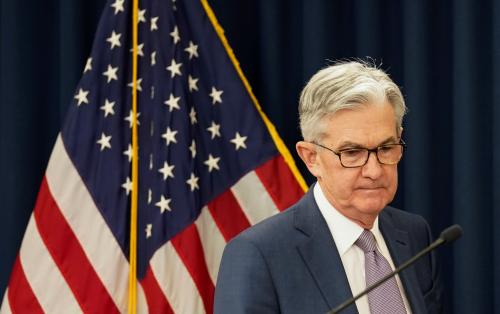This post will be updated throughout the ongoing coronavirus pandemic.
The coronavirus crisis has escalated sharply in the U.S., with school closures, event cancellations, and mandatory work-from-home policies. A recession is inevitable. The Federal Reserve has stepped in, saying, “The coronavirus outbreak has harmed communities and disrupted economic activity in many countries, including the United States. The Federal Reserve is prepared to use its full range of tools to support the flow of credit to households and business.”
What tools does the Fed have, and what have they done with them?
- Federal funds rate: The Fed has cut the federal funds rate, the rate banks pay to borrow from each other overnight, by a total of 1.5 percentage points since March 3, bringing it down to zero. The federal funds rate is a benchmark for other short-term rates, and also affects longer-term rates, so this move will lower the cost of borrowing on mortgages, auto loans, home equity loans, and other loans, and will also reduce the interest income that savers get.
- Discount rate: The Fed lowered the rate that it charges banks for loans from its discount window by 1.5 percentage points, from 1.75 percent to 0.25 percent, lower than during the Great Recession of 2007-2009. These loans are typically overnight—meaning that they are taken out at the end of one day and repaid the following morning—but the Fed has extended the terms to 90 days. Banks pledge a wide variety of collateral (securities, loans, etc.) to the Fed in exchange for cash, so the Fed is not taking on much risk in making these loans. The cash allows banks to keep functioning: depositors can continue to withdraw money, and the banks can make new loans. Banks are sometimes reluctant to borrow from the discount window because they fear that if word leaks out, markets and others will think they are in trouble. To counter this stigma, eight big banks agreed to borrow from the discount window.
- Quantitative easing: The Fed also said it would buy at least $500 billion in Treasury securities and $200 billion in mortgage-backed securities over “the coming months” to smooth the functioning of the Treasury and mortgage-backed securities markets that grew dysfunctional last week. “[T]he primary purpose of these security purchases is to restore smooth market functioning so that credit can continue to flow. The purchases will also foster more accommodative financial conditions,” Fed Chair Jerome Powell said. He declined to call it “quantitative easing” (QE), a term born during the Great Recession when the Fed bought trillions of long-term securities. Everyone else is calling it QE. In the first day, the Fed bought $40 billion in longer-term securities, as much as it was buying a month during QE.
- Forward guidance: Using another tool honed during the Great Recession, the Fed offered forward guidance on the future path of its key interest rate, signaling that rates will likely remain low, as Powell said, “until we’re confident that the economy has weathered recent events and is on track to achieve our maximum employment and price stability goals.”
- Encouraging banks to lend: The Fed is temporarily relaxing regulatory requirements. It eliminated banks’ reserve requirement—the percent of deposits that banks must hold as reserves to meet cash demand—though this is largely irrelevant because banks currently hold far more than the required reserves. It is also encouraging banks to dip into their regulatory capital and liquidity buffers, so they can increase lending during the downturn. The reforms instituted after the 2008 crisis require banks to hold additional loss-absorbing capital to prevent future bailouts. But these capital buffers can be utilized during a downturn to stimulate lending, and the Fed is encouraging that now. (To preserve capital, big banks also are suspending buybacks of their shares.)
- International swap lines: Using another tool that was important in the Great Recession, the Fed is making U.S. dollars available to other central banks, so they can lend to banks that need them. The Fed gets foreign currencies in exchange, and charges interest on the swaps. The Fed has cut the rate it charges on those swaps with central banks in Canada, England, the Eurozone, Japan, and Switzerland, and extended the maturity of those swaps. It has also extended the swaps to the central banks of Australia, Brazil, Denmark, Korea, Mexico, New Zealand, Norway, Singapore, and Sweden.
- Lending facilities: The Fed relaunched the Commercial Paper Funding Facility (CPFF) and the Primary Dealer Credit Facility, two crisis-era facilities for short-term loans. To do so, the Fed had to obtain the approval of the Treasury Secretary to invoke emergency lending authority under Section 13(3) of the Federal Reserve Act. Commercial paper is a $1.2 trillion market in which firms issue unsecured short-term debt to certain money market funds and others, to finance day-to-day operations.
Through the Commercial Paper Funding Facility, the Fed buys commercial paper, essentially lending directly to corporations for up to three months at a rate that is 2 percentage points higher than overnight lending rates. “By eliminating much of the risk that eligible issuers will not be able to repay investors by rolling over their maturing commercial paper obligations, this facility should encourage investors to once again engage in term lending in the commercial paper market,” the Fed said. “An improved commercial paper market will enhance the ability of businesses to maintain employment and investment as the nation deals with the coronavirus outbreak.” To cover any losses, the U.S. Treasury put $10 billion into the CPFF.
Through the Primary Dealer Credit Facility, the Fed will offer low interest rate (currently 0.25 percent) loans up to 90 days to 24 large financial institutions known as primary dealers, and the dealers will provide equities and investment grade debt securities, including commercial paper and municipal bonds, as collateral. The goal is to keep the credit markets functioning at a time of stress when institutions and individuals are inclined to avoid risky assets and hoard cash, and dealers may encounter barriers to financing rising inventories of securities they may accumulate as they make markets. Or, as the Fed put it, “the facility will allow primary dealers to support smooth market functioning and facilitate the availability of credit to businesses and households.”
- Repo operations: The Fed has vastly expanded the scope of its repurchase agreement (repo) operations to funnel cash to money markets. The repo market is where firms borrow and lend cash and securities short-term, usually overnight. Disruptions in the repo market affect the federal funds rate, the Fed’s primary tool for achieving its inflation and employment mandate. The Fed’s facility makes cash available to the primary dealers in exchange for Treasury and other government-backed securities. Before coronavirus turmoil hit the market, the Fed was offering $100 billion in overnight repo and $20 billion in two-week repo. It ramped up the operations on March 9, offering $175 billion in overnight and $45 billion in two-week repo. Then, on March 12, the Fed announced a huge expansion. It is now on a weekly basis offering repo at much longer terms: $500 billion for one-month repo and $500 billion for three months. On March 17, at least for a time, it also greatly increased overnight repo offered. The Fed said that these liquidity operations aimed to “address highly unusual disruptions in Treasury financing markets associated with the coronavirus outbreak.” In short, the Fed is now willing to loan what is essentially an unlimited amount of money to the markets, and uptake has fallen well below amounts offered.
- Backstop money market mutual funds: The Fed has launched the Money Market Mutual Fund Liquidity Facility (MMLF) to banks against collateral they purchase from prime money market funds, the ones that invest in corporate short-term IOUs known as commercial paper, as well as in Treasury securities. Since the outbreak of COVID-19, investors have been withdrawing from money market funds en masse. In order to meet outflows, these funds are selling securities, but disruptions in the financial markets make it difficult to sell, even if the securities are all of high quality and very short maturities. The Fed said that the facility “will assist money market funds in meeting demands for redemptions by households and other investors, enhancing overall market functioning and credit provision to the broader economy.” As with the CPFF, the Treasury provided $10 billion from its Exchange Stabilization Fund to cover potential losses.
On March 20, the Fed expanded eligible collateral to include highly rated municipal debt with maturities of up to 12 months. This will allow banks to funnel cash into the municipal debt market, where stress has been building due to a lack of liquidity.
Why are the Fed’s actions important?
The steps that have been taken by federal, state, and local officials to mitigate the spread of the virus will limit spending and hurt the incomes of businesses and households, leading to a recession. The Fed is trying to ensure that credit continues to flow to households and businesses during this difficult time and that the financial system doesn’t amplify the shock to the economy. It also wants to do what it can to limit the permanent damage to the economy so that when the pandemic recedes, the economy can grow again, and supply goods and services to meet demand. As our colleague Ben Bernanke, the former Fed chair, said (in so many words) during the global financial crisis: we didn’t set out to save Wall Street, but in order to save Main Street, we had to save Wall Street.
In many other countries, most of the credit flows through the banks. In the U.S., a lot flows through the capital markets, so the Fed is trying to keep them functioning as smoothly as possible. As another one of our colleagues, Don Kohn, former Federal Reserve Vice Chair, said recently:
“The Treasury market in particular is the foundation for trading in many other securities markets in the U.S. and around the world; if it’s disrupted, the functioning of every market will be impaired. The Fed’s purchase of securities is explicitly aimed at improving the functioning of the Treasury and MBS markets, where market liquidity had been well below par in recent days.”
When financial markets are clogged, firms tend to draw on bank lines of credit, and that can lead banks to sell Treasury and other securities or pull back on other loans. Boeing Company, for instance, drew down a $13.8 billion credit line with its banks, and it was not alone. Micron Technology, Hilton, and Air France-KLM Group, among others, all drew from their revolving credit facilities. The Fed is supplying unlimited liquidity to the banks, so they can meet credit drawdowns and relieve any balance sheet strain.
What more can the Fed do?
The Fed’s powers and tools, as impressive as they are, aren’t sufficient to cope with the economic harm of the COVID-19 crisis. That’s why there is likely to be a big fiscal response from Congress and the President—spending increases and perhaps checks to every household. As Powell said when the Fed cut rates nearly to zero, “Monetary policy has a role…Our original role was providing liquidity to financial systems when they are under stress. And that’s really part of what we did today. The other role is to support demand through lower interest rates, and we did that… We do think fiscal response is critical… Typically fiscal policy does play a major role when there are downturns. You’ve seen that in many past downturns. And that’s beyond just the automatic stabilizers. Sometimes fiscal policy comes in on a discretionary basis. And that will probably need to be the case here as well.”
But the Fed does have a few more moves left.
On the monetary policy front, there’s not a lot left. The Fed could cut interest rates below zero—essentially charging a fee for any bank that puts money on deposit at the Fed. Several other central banks have moved to negative rates, but the Fed has said it probably won’t. The Fed also could increase its purchases of long-term Treasury debt and mortgage-backed securities to push long-term interest rates down, but those rates already are very low.
Still, as Ben Bernanke and Janet Yellen, both former Fed chairs and now our colleagues at the Hutchins Center, outlined recently in the Financial Times, there is more that the Fed could do.
Here are some steps the Fed could take:
- Restart the Term Auction Facility, an alternative to the discount window. “Many banks were reluctant to borrow at the discount window out of fear that their borrowing would become known and would be erroneously taken as a sign of financial weakness,” the Fed said. Under the TAF, the Fed auctioned 28-day and, later, 84-day loans to U.S. and foreign banks in generally sound condition. “The TAF enabled the Federal Reserve to provide term funds to a broader range of counterparties and against a broader range of collateral than it could through open market operations. As a result, the TAF helped promote the distribution of liquidity when unsecured bank funding markets were under stress. It also provided access to term credit without the stigma that had been associated with use of the discount window.” Discount window borrowing peaked at a little more than $100 billion during the crisis; TAF borrowing at $450 billion.
- Restart other lending programs, such as the Term Asset-Backed Securities Loan Facility (TALF). Through this facility, the Fed supported lending to households and small businesses by lending to holders of asset-backed securities collateralized by recently made or new loans to consumers and small businesses. As with the CPFF, the Fed probably would need some capital from Treasury or Congress to do this.
- Follow other central banks with what’s known as a “funding for lending” scheme, essentially offering banks greater access to very cheap, longer-term loans if they, in turn, increase their lending to small and medium-sized businesses and households.
- Broaden the range of financial firms who can borrow from the PDCF beyond the two dozen firms designated as primary dealer to include hedge funds and other institutions not currently eligible.








Commentary
What’s the Fed doing in response to the COVID-19 crisis? What more could it do?
March 20, 2020